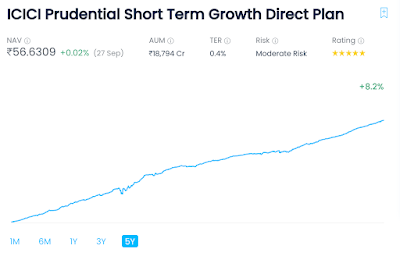I learnt about debt mutual funds before I learnt about equity mutual funds. I consider myself more knowledgeable in debt more than in equity. What follows is one of the first lessons I learnt about debt mutual funds.
When you come across a debt fund that has given incredibly high return than its peers, it’s usually a sign that this fund has had a troublesome past. In the screenshot below, we see that Bank of India AMC’s Short Duration debt fund is topping the charts with 14% and 12% returns while other funds have given merely 7.5% or 6% return.
It takes only a few seconds to see why the high returns.
This is ICICI’s short duration debt fund. Nothing stands out here: just some volatility over the past 5 years, and it’s given 8.2% annual return.
Now look at the Bank of India fund: it has seen about 3 credit events in the past 5 years! Thankfully, the fund has recovered from 2 of these credit events, it looks like. After all that drama, this fund has managed to earn at 4.1% per annum over the past 5 years.
That was interesting to see, but what’s the takeaway? If we cannot rely on recent return data, what data can we look at then? I am no expert, but the following is what I do.
- I like to look at past portfolios and fact sheets of the fund to see how much risk they take. I don’t like anything below AAA. So many funds invest in AA bonds since they are pretty safe on typical days, but I am too conservative for that.
- I especially like funds that choose PRC matrix positions of A-I, A-II, and A-III since they commit to not holding too much sub-AAA debt. Unfortunately, many funds that never/seldom hold sub-AAA debt choose the ‘B’ position just to have some extra wiggle room.
Can we “buy the dip”?
New investors cannot earn outsized return by investing in debt funds after they have seen credit events. If someone bought Bank of India Short Duration debt fund a year ago, what return they’ll be looking at? Definitely not 14% because they wouldn’t have gotten access to the troubled bonds. They will likely be getting around 7.5% which seems to be the typical return.
Once there is a credit event, the troubled debt assets are moved to an illiquid “segregated portfolio”. New subscriptions to the scheme only get access to the “core portfolio”, i.e. the debt assets that are not troubled. Existing investors who have a share in the segregated portfolio will have to live with the troubled bonds until either the bonds become good again or go completely to zero.
You seldom win by taking credit risk. It’s prudent to exhaust your risk appetite in “safer” assets like equity rather than betting on lower quality debt.




No comments:
Post a Comment